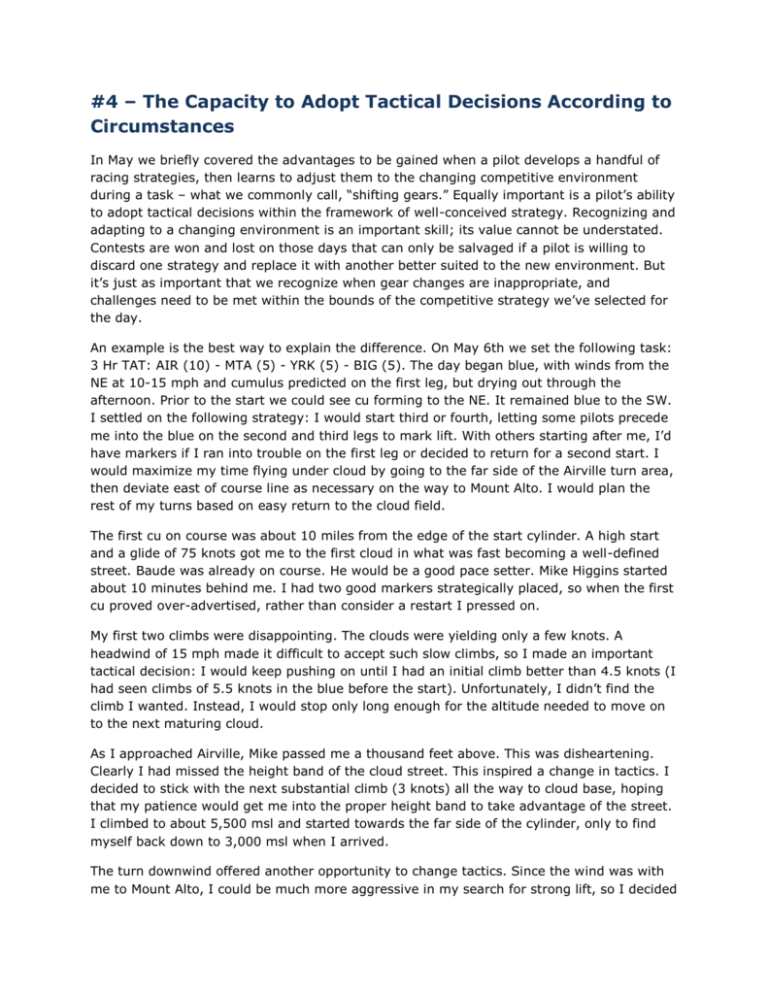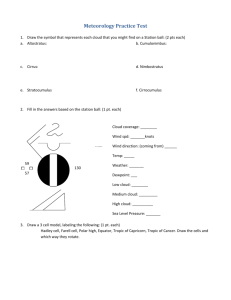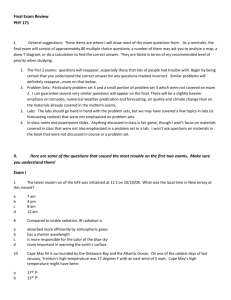The Capacity to Adopt Tactical Decisions According to Circumstances
advertisement

#4 – The Capacity to Adopt Tactical Decisions According to Circumstances In May we briefly covered the advantages to be gained when a pilot develops a handful of racing strategies, then learns to adjust them to the changing competitive environment during a task – what we commonly call, “shifting gears.” Equally important is a pilot’s ability to adopt tactical decisions within the framework of well-conceived strategy. Recognizing and adapting to a changing environment is an important skill; its value cannot be understated. Contests are won and lost on those days that can only be salvaged if a pilot is willing to discard one strategy and replace it with another better suited to the new environment. But it’s just as important that we recognize when gear changes are inappropriate, and challenges need to be met within the bounds of the competitive strategy we’ve selected for the day. An example is the best way to explain the difference. On May 6th we set the following task: 3 Hr TAT: AIR (10) - MTA (5) - YRK (5) - BIG (5). The day began blue, with winds from the NE at 10-15 mph and cumulus predicted on the first leg, but drying out through the afternoon. Prior to the start we could see cu forming to the NE. It remained blue to the SW. I settled on the following strategy: I would start third or fourth, letting some pilots precede me into the blue on the second and third legs to mark lift. With others starting after me, I’d have markers if I ran into trouble on the first leg or decided to return for a second start. I would maximize my time flying under cloud by going to the far side of the Airville turn area, then deviate east of course line as necessary on the way to Mount Alto. I would plan the rest of my turns based on easy return to the cloud field. The first cu on course was about 10 miles from the edge of the start cylinder. A high start and a glide of 75 knots got me to the first cloud in what was fast becoming a well-defined street. Baude was already on course. He would be a good pace setter. Mike Higgins started about 10 minutes behind me. I had two good markers strategically placed, so when the first cu proved over-advertised, rather than consider a restart I pressed on. My first two climbs were disappointing. The clouds were yielding only a few knots. A headwind of 15 mph made it difficult to accept such slow climbs, so I made an important tactical decision: I would keep pushing on until I had an initial climb better than 4.5 knots (I had seen climbs of 5.5 knots in the blue before the start). Unfortunately, I didn’t find the climb I wanted. Instead, I would stop only long enough for the altitude needed to move on to the next maturing cloud. As I approached Airville, Mike passed me a thousand feet above. This was disheartening. Clearly I had missed the height band of the cloud street. This inspired a change in tactics. I decided to stick with the next substantial climb (3 knots) all the way to cloud base, hoping that my patience would get me into the proper height band to take advantage of the street. I climbed to about 5,500 msl and started towards the far side of the cylinder, only to find myself back down to 3,000 msl when I arrived. The turn downwind offered another opportunity to change tactics. Since the wind was with me to Mount Alto, I could be much more aggressive in my search for strong lift, so I decided to push on until I connected with a strong thermal. I quickly found 5 knots in the blue between mature cu on a Uvalde-ish street! As I climbed, wisps began to form above me. The decision to take full tactical advantage of the wind on a downwind leg had revealed the nature of the day. Below 5,000 feet, the lift was tight cored and in the blue. Near cloudbase, the lift homogenized into broad streets, no doubt the result of a slight change in wind speed or direction. The clouds, which looked like they were set on pillars of lift, were wholly disconnected with the ground. From this point on, if low, I would use the clouds to define regions of lift, but focus my search on the terrain ahead. If high, I would shift my focus back to the clouds to define and use lift streets. I made no change in strategy throughout the flight. My speed at the first turn was only 41 mph – very disappointing. However, with my change in tactics, I quickly caught up with Mike again, and applied them throughout the rest of the flight. I brought my average speed up to 57 mph after adding an additional 130 miles to my less than ideal first leg. I had squandered what should have been my best leg, but it at least it taught me how to fly the rest of the day. If I’d caught on earlier, I might have approached 70mph. But such is the stuff of competitive soaring… opportunities unexploited litter our memories.








